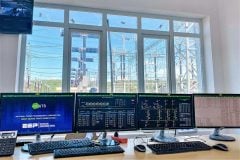Application for substation automation
Substation Automation is a supervisory management and control system that lies in between transmission and distribution systems.

The interests on substation automation have been increasing rapidly due to its numerous benefits to utilities. It has advanced further than a traditional Supervisory Control and Data Acquisition (SCADA) system providing additional capability and information that can be used to further improve operations, maintenance and efficiencies in substations.
The desire and the need of merging the communication capabilities of all relays and IEDs in a substation has thus been clearly recognized, which is capable of providing not only data gathering and setting capability but also remote control.

Furthermore, multiple IEDs can share data or control commands at higher speeds to perform new distributed protection, and control functions.
Interoperability needs to be achieved in a substation between protective relays from different manufacturers so that substation level interlocking, protection and control functions can be realized improving the efficiency of microprocessor based relay applications.
Satellite communication
Recent developments in communication technologies have enabled reliable remote control systems which have the capability of monitoring the real time operating conditions and performance of electric systems.
These communication technologies can be classified into four classes:
- Power line communication,
- Satellite communication (subject of this article)
- Wireless communication and
- Optical fiber communication.
Each communication technology has its own advantages and disadvantages that must be evaluated to determine the best communication infrastructure for substation automation. In this article, a review of satellite communication technology is presented with the special emphasis on their application for substation automation.
Satellite communication can offer pretty innovative solutions for remote control and monitoring of substations.
In practical applications, Very Small Aperture Terminal (VSAT) satellite services are already available that are especially tailored for remote substation monitoring applications.
Furthermore, with the latest developments in electric system automation, satellite communication is not only used for remote control and monitoring of substations, but also used for Global Positioning System (GPS) based time synchronization, which provides microsecond accuracy in time synchronization.
In addition, satellites can be used as a backup for the existing substations communication networks. In case of congestion or link failures in communication, critical data traffic can be routed through satellites.
In this article, both advantages and disadvantages of satellite communication technologies have been reviewed with respect to substation automation.

Two advantages
Following are the advantages of using satellite communication for remote monitoring:
1. Geographic coverage
Satellite communications have unique advantages over conventional long distance transmissions. This communication trend is capable of spanning long distance irrespective of the physical condition.
2. Higher Bandwidth
Satellite communication has very large bandwidth capacity as it is widely used for the broadcasting of video streaming. Thus this higher bandwidth can be utilized for the transmission of mission critical data and messages within substations.
Two disadvantages
Followings are the disadvantages of using satellite communication as a communication technology:
1. Long delay
As for as the transmission characteristics for satellite communication are concerned, round–trip delay is the growing concern which is comparatively higher than the wired network.
2. Satellite channel characteristics
Performance of satellite channels is greatly affected by the change in operating climate due to weather or by the effect of fading thereby degrading the efficiency of the whole satellite communication system.
Reference: A Survey of Communication Network Paradigms for Substation Automation – Mahmood Qureshi, Ali Raza, Dileep Kumar, Sang–Sig Kim, Un–Sig Song, Min–Woo Park, and Hyuk–Soo Jang, Hyo–Sik Yang and Byung–Seok Park











Good Information , as we are into satellite monitoring and Interception system works only for Govt agencies . It’s really great info to learn thanks
Nice and informative!
thank you for your for your contribution
Very informative and useful post, its great to read such information. we never had idea about this type satellite communication.
thanks , great work